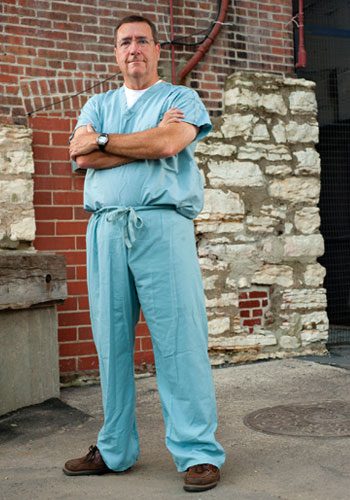
myth four //
Investigations are fast-paced
McCunniff sees the actors on TV use equipment that he’s familiar with, like a handheld portable X-ray unit. But even with the same technology, investigations in real life just don’t come together quite so quickly. “The things they do between commercials take days to do in real life,” he says. In addition to the quick resolution, most crime shows are action packed—shootouts, shootings and fights are commonplace. But in real life, police officers don’t draw their weapons, Holsinger says, unless they’re open to the possibility of ending someone’s life.
“When a gun is drawn, that’s a rare, important event,” he says. “Cops aren’t sitting around in coffee shops twirling their guns.” Police officers spend a lot of time in an office doing paperwork and it can be deadly boring, he says. There are also actions that police officers perform in the field that in turn require them to submit paperwork—something rarely depicted on TV. In reality, when an officer draws a weapon and discharges a shell, he or she must complete paperwork. The officer has to document exactly what happened and where the bullet went. “Those shows with the super-star cop—the guy that is always shooting or shot at and never hit—that’s unrealistic, but it’s entertaining,” Lomax says.
myth five //
The courtroom is full of drama
Objections, screaming, crying and general acts of disorderly conduct are common scenes that play out in courtroom dramas like Law & Order. But in these shows, things are said and done for the sake of drama that would never happen in an actual court of law, Hunt says. The majority of cases in the court system get settled without going to trial. “A case gets disposed of and it should,” Holsinger says. “There’s nothing exciting about two attorneys and a judge coming to an agreement behind closed doors and walking out of a room. You can’t make a story out of that.”
Hunt says the yelling and shouting viewers see in court on TV rarely happens and is never allowed in real life. “It’s a controlled atmosphere, and it’s the judge’s job to keep it under control,” he says. “We just don’t have the screaming and shouting and the Perry Mason moment where someone admits his guilt.”
The bottom line is that crime on television can be harmless entertainment. But keeping it in perspective helps society understand it, especially because the genre isn’t going anywhere. The beast will continue to feed itself. “The genre makes criminal justice more visible, therefore, we will continue to see it in our entertainment,” Holsinger says. “Crime will continue to be a dominant part of our culture. We have a long way to go before we see crime shrink.” Despite the inaccuracies TV portrays, the genre consistently puts forth one kernel of truth: crime doesn’t pay. “The TV cops use all this fancy equipment to catch the suspect—and the suspect gets caught,” Lomax says. “That’s a boost for real-life law enforcement.”
